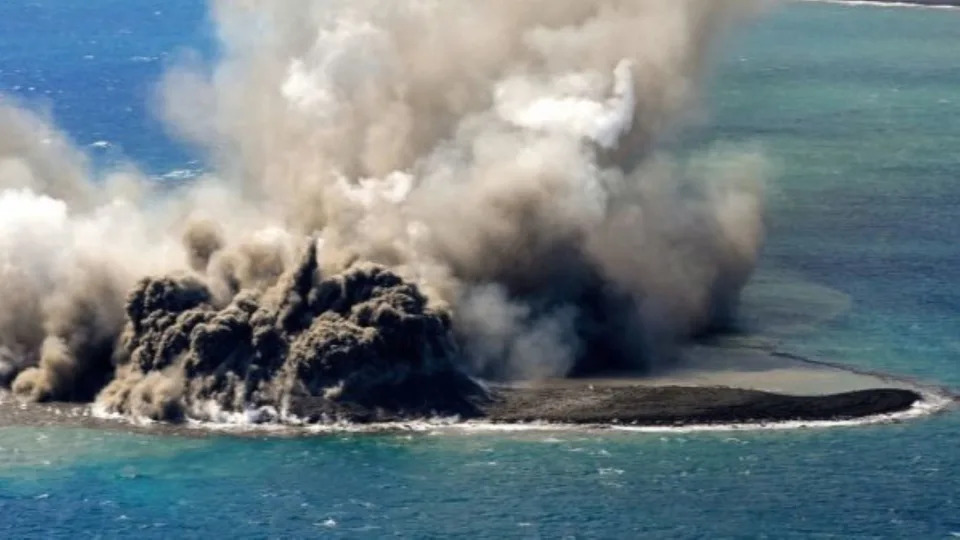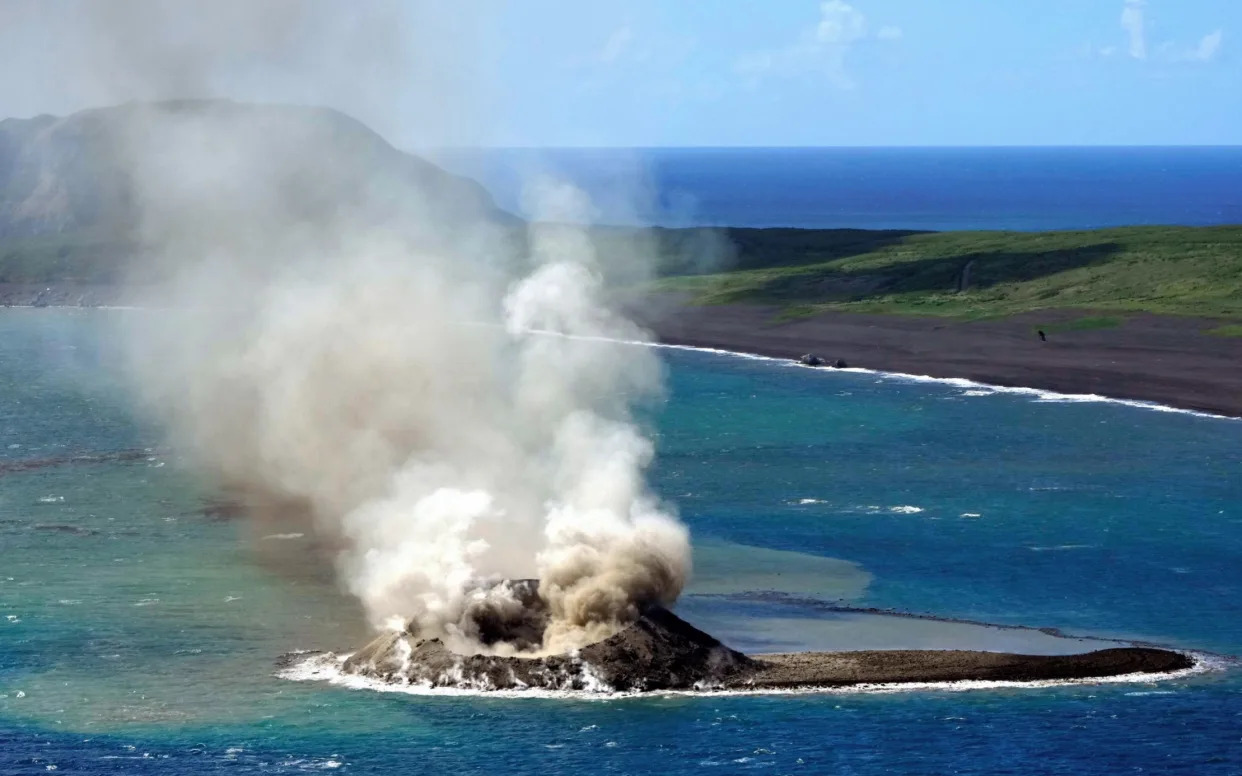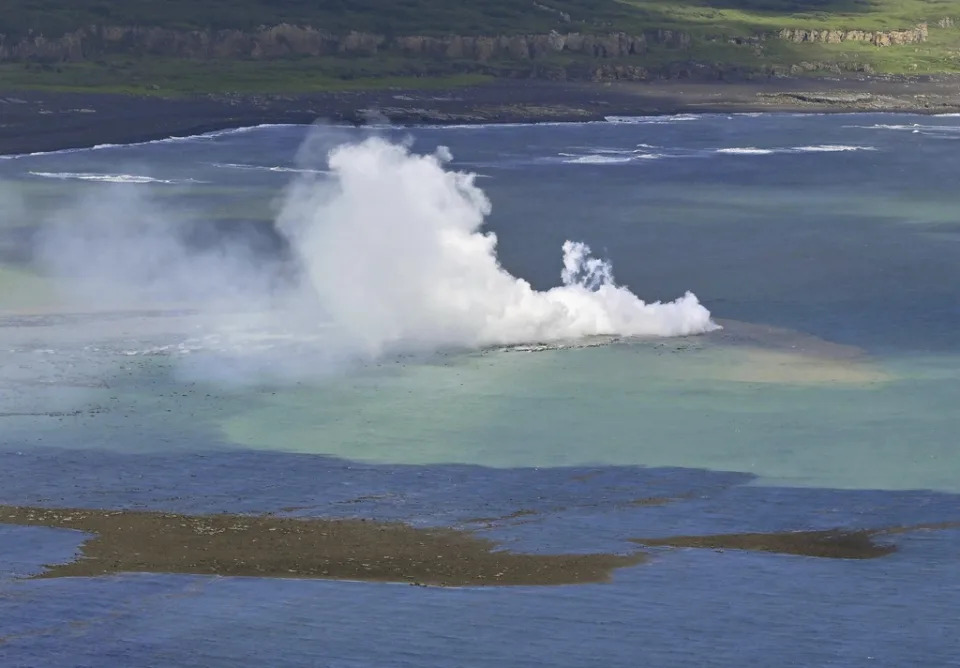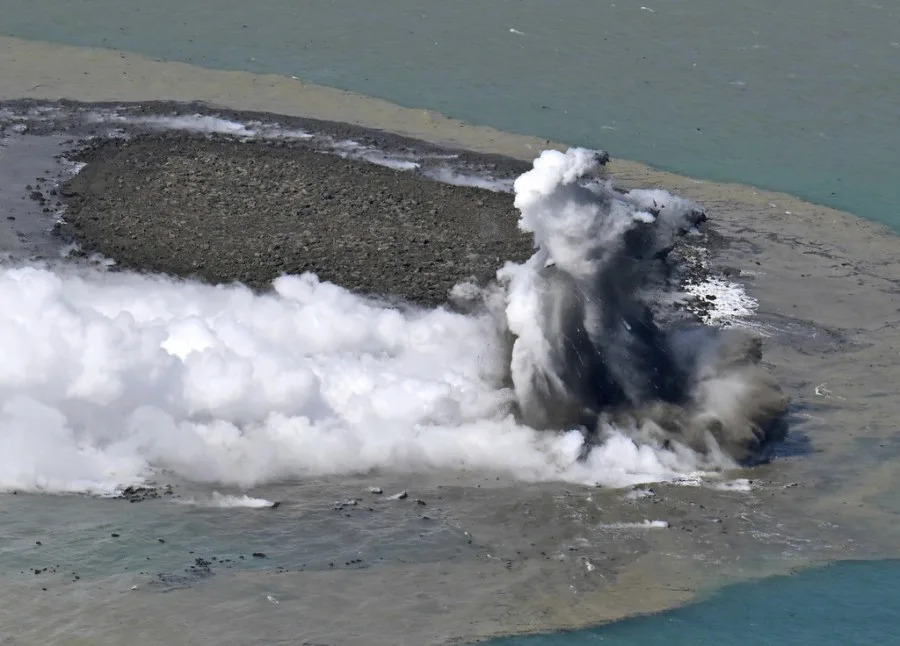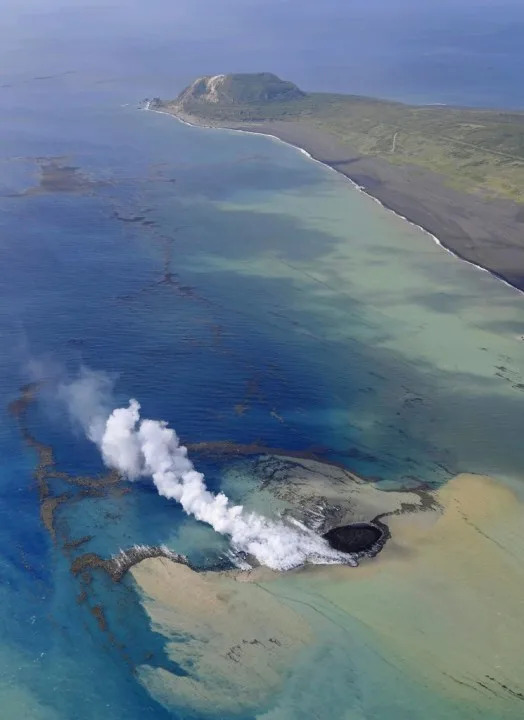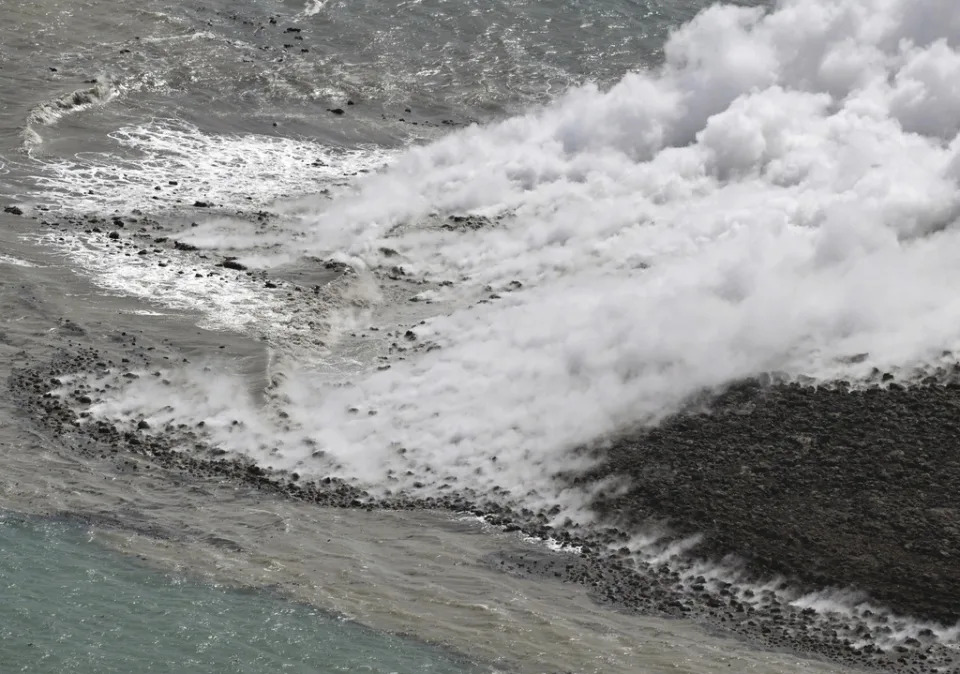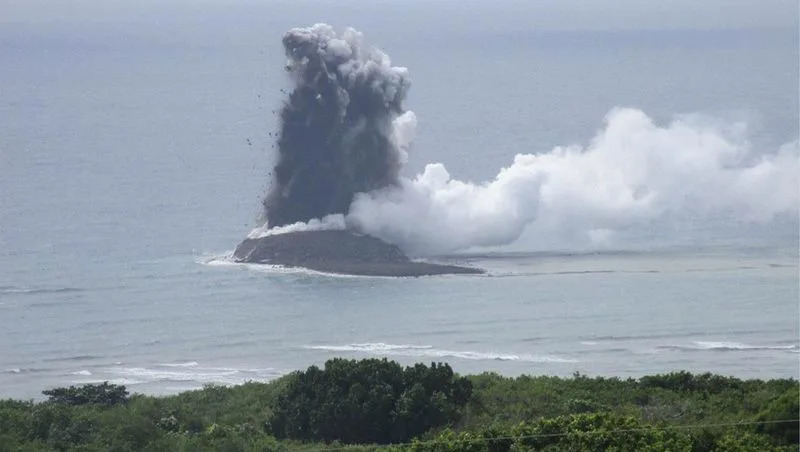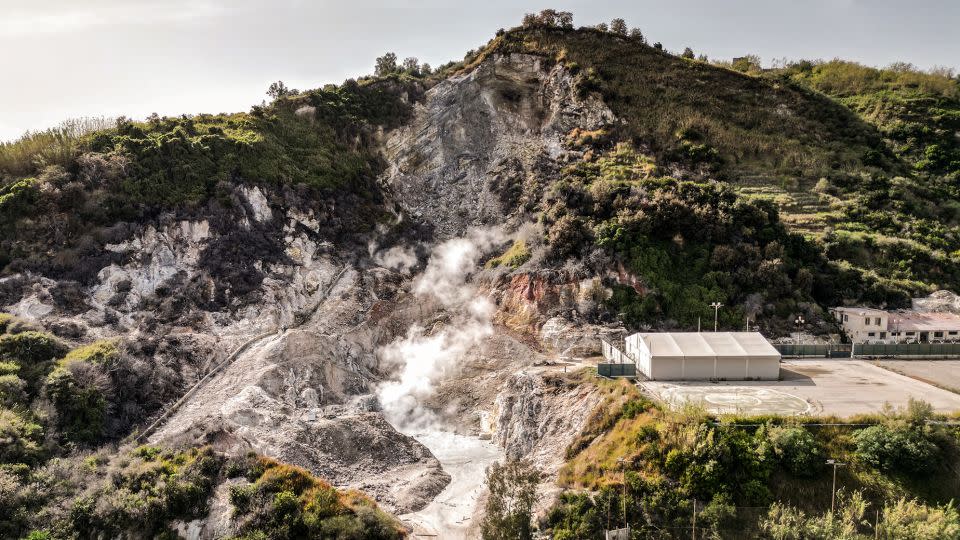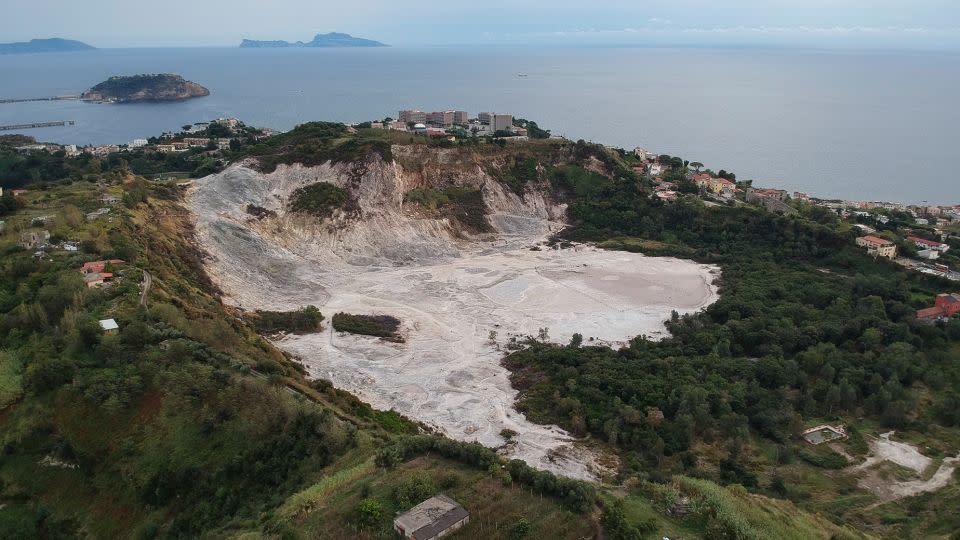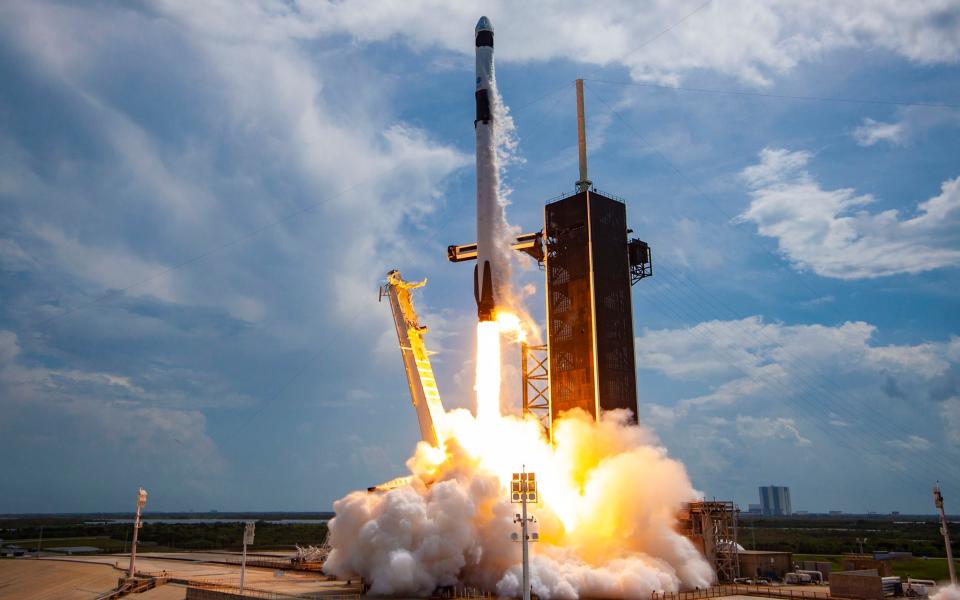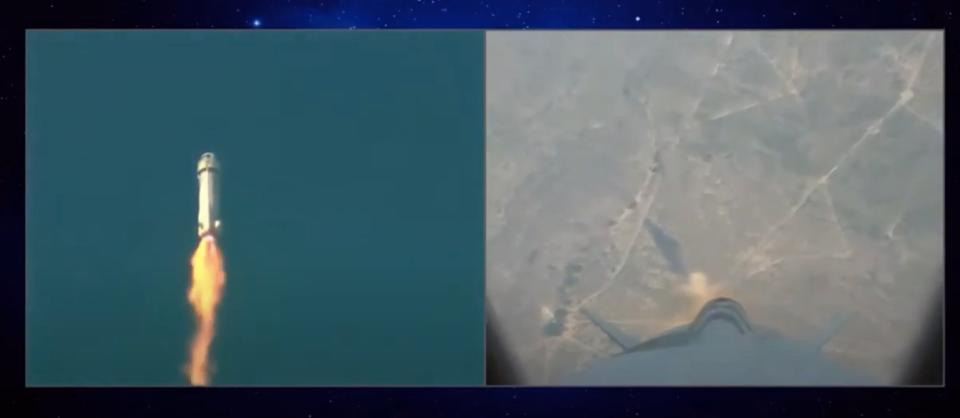Rare Species of Mammal Believed to Have Been Extinct Spotted for First Time in Decades
Stacey Ritzen
Fri, November 10, 2023

Getty Images
Oxford University researchers on an expedition to Indonesia were stunned to have come across video evidence of an extremely rare species of echidna that had been considered critically endangered on the IUCN Red List of Threatened Species for decades, and possibly even extinct.
The Attenborough echidna, named for natural historian and biologist Sir David Attenborough, is one of three species of the Zaglossus genus of echidna that lives only in the Cyclops Mountains on the island of New Guinea. Echidna most closely resemble hedgehogs or porcupines in appearance, in that they're covered in coarse hair that resembles spines. There also are one of only two egg-laying mammals; the other being the duck-billed platypus.
The creatures are often referred to as "living fossils" as they are believed to have first appeared on Earth around 200 million years ago when dinosaurs still roamed. While the ancestor of the species was aquatic, echidnas eventually adapted to life on land.
As nocturnal creatures who live in burrows and tend to be very shy, echidnas are rarely seen, making the discovery that much more groundbreaking.
Researchers recorded four three-second clips of Attenborough's long-beaked echidna during a month-long expedition to treacherous, previously unexplored stretches of the rainforest habitat. The mountains are steep and dangerous, filled with deadly venomous snakes and leeches that drop from trees to feed on blood.
Dr, James Kempton, an Oxford University biologist who led the multi-national Expedition Cyclops, told BBC News that he and the entire team were "euphoric" at the discovery of the creature, which they identified in camera trap footage.
"I'm not joking when I say it came down to the very last SD card that we looked at, from the very last camera that we collected, on the very last day of our expedition," Kempton explained. He added that he had already alerted Attenborough to the rediscovery via letter correspondence, who was "absolutely delighted."
Before the video footage was captured, the only evidence of the Zaglossus attenboroughi that existed was a deceased specimen that had been collected near the top of Mount Rara in the Cyclops Mountains in 1961. It wasn't until 1998 that X-rays revealed that the specimen was not a juvenile of another echidna species, and was subsequently named after Attenborough.
The "lost echidna" was one of many discoveries the team made during the expedition. In addition to "several dozen" new species of insects and frogs, they also found a new species of tree-dwelling shrimp and a previously unknown cave system.
"The top of the Cyclops are really unique," said Gison Morib, a local conservationist who partnered with Oxford University on the expedition. "We have to protect these sacred mountains. There are so many endemic species we don't know."
First-ever images prove 'lost echidna' not extinct
Jonah Fisher and Charlie Northcott - BBC News
Fri, November 10, 2023
Scientists have filmed an ancient egg-laying mammal named after Sir David Attenborough for the first time, proving it isn't extinct as was feared.
An expedition to Indonesia led by Oxford University researchers recorded four three-second clips of Attenborough's long-beaked echidna.
Spiky, furry and with a beak, echidnas have been called "living fossils".
They are thought to have emerged about 200 million years ago, when dinosaurs roamed the Earth.
Until now, the only evidence that this particular species Zaglossus attenboroughi existed was a decades-old museum specimen of a dead animal.
"I was euphoric, the whole team was euphoric," Dr James Kempton told BBC News of the moment he spotted the Attenborough echidna in camera trap footage.
"I'm not joking when I say it came down to the very last SD card that we looked at, from the very last camera that we collected, on the very last day of our expedition."
Dr Kempton said he had been in letter correspondence with Sir David about the rediscovery and that he was "absolutely delighted".
Dr Kempton, a biologist from Oxford University, headed a multi-national team on the month-long expedition traversing previously unexplored stretches of the Cyclops Mountains, a rugged rainforest habitat 2,000m (6,561ft) above sea level.
In addition to finding Attenborough's "lost echidna" the expedition discovered new species of insects and frogs, and observed healthy populations of tree kangaroo and birds of paradise.
Echidnas and other animals named after Sir David Attenborough
Aside from the duck-billed platypus, the echidna is the only mammal that lays eggs. Of the four echidna species three have long beaks, with the Attenborough echidna, and the western echidna considered critically endangered.

Factbox on echidna
Previous expeditions to the Cyclops Mountains had uncovered signs, such as 'nose pokes' in the ground, that the Attenborough echidna was still living there.
But they were unable to access the remotest reaches of the mountains and provide definitive proof of their existence.
That has meant that for the last 62 years the only evidence that Attenborough echidna ever existed has been a specimen kept under high security in the Treasure Room of Naturalis, the natural history museum of the Netherlands.
"It's rather flat," Pepijn Kamminga, the collection manager at Naturalis, says as he holds it for us to see.
To an untrained eye it's not dissimilar to a squashed hedgehog because when it was first gathered by Dutch botanist Pieter van Royen it wasn't stuffed.
The importance of the specimen only became clear in 1998 when X-rays revealed it was not a juvenile of another echidna species but in fact fully grown and distinct. It was then that the species was named after Sir David Attenborough.
"When that was discovered, people thought, well, maybe it's extinct already because it's the only one," Mr Kamminga explains. "So this [the rediscovery] is incredible news."
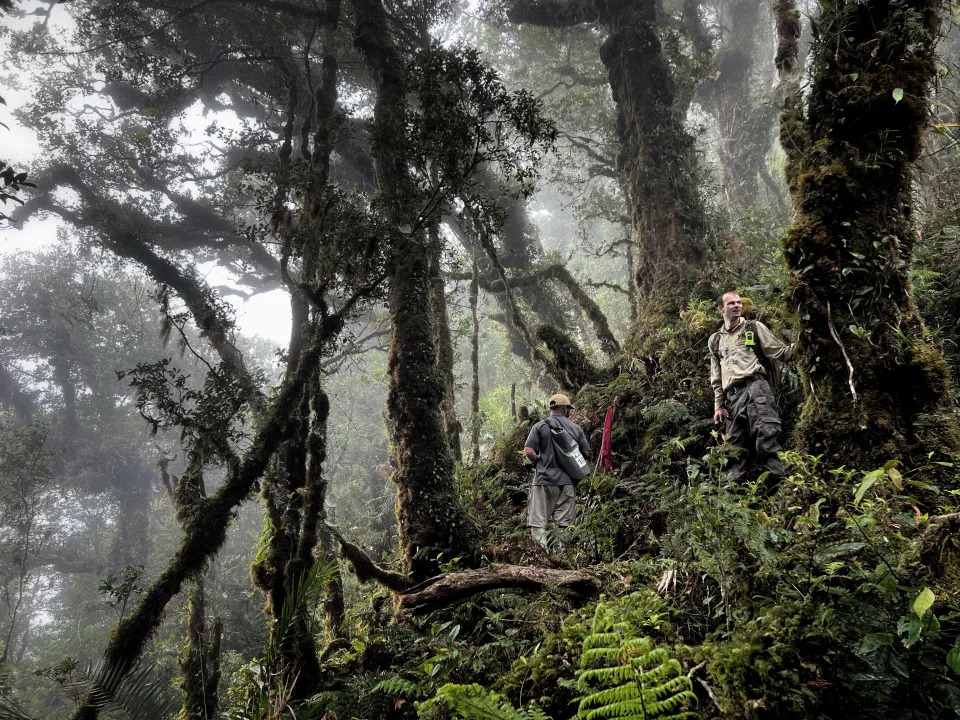
Dr James Kempton led the expedition to the Cyclops Mountains
The Cyclops Mountains are precipitously steep and dangerous to explore. To reach the highest elevations, where the echidna are found, the scientists had to climb narrow ridges of moss and tree roots - often under rainy conditions - with sheer cliffs on either side. Twice during their ascent the mountains were hit by earthquakes.
"You're slipping all over the place. You're being scratched and cut. There are venomous animals around you, deadly snakes like the death adder," Dr Kempton explains.
"There are leeches literally everywhere. The leeches are not only on the floor, but these leeches climb trees, they hang off the trees and then drop on you to suck your blood."

Dr Leonidas-Romanos Davranoglou says they have found several dozen new species
Once the scientists reached the higher parts of the Cyclops it became clear the mountains were full of species that were new to science.
"My colleagues and I were chuckling all the time," Dr Leonidas-Romanos Davranoglou, a Greek insect specialist, said.
"We were so excited because we were always saying, 'this is new, nobody has seen this' or 'Oh my God, I can't believe that I'm seeing this.' It was a truly monumental expedition."
Dr Davranoglou broke his arm in the first week of the expedition but remained in the mountains collecting samples. He says they have already confirmed "several dozen" new insect species and are expecting there to be many more. They also found an entirely new type of tree-dwelling shrimp and a previously unknown cave system.
Gison Morib, a conservationist with Yappenda, a local non-profit that partnered with Oxford University on the expedition, said: "The top of the Cyclops are really unique. I want to see them protected.
"We have to protect these sacred mountains. There are so many endemic species we don't know."
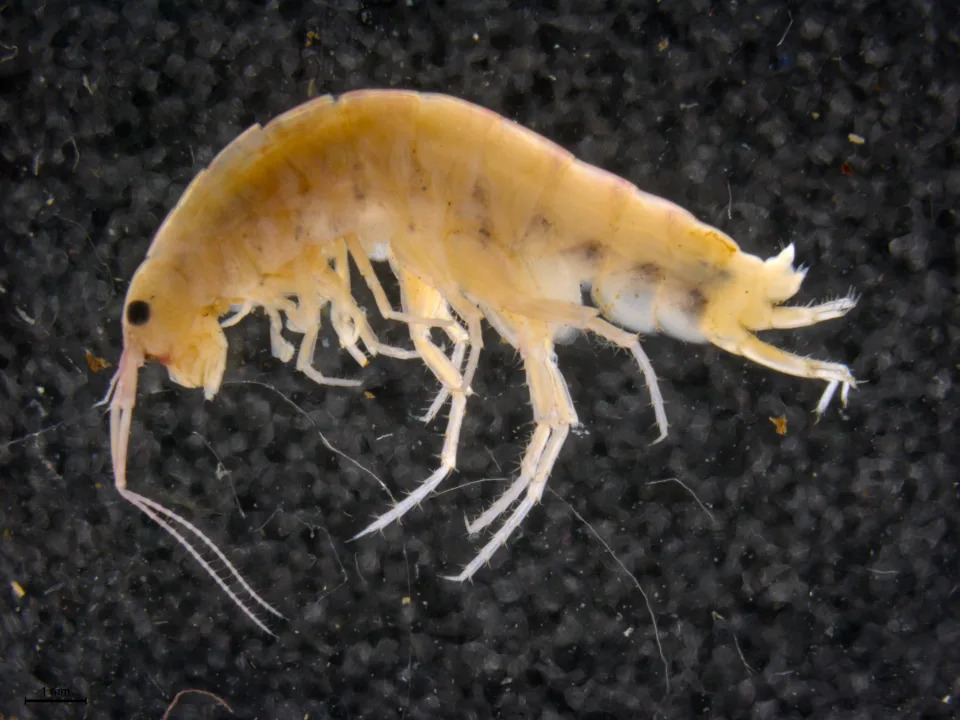
A new species of terrestrial shrimp, found in the soil and the trees of the Cyclops Mountains
Sacred mountains
Previous expeditions had struggled to reach the parts of the Cyclops Mountains where the echidnas live because of the belief of local Papuans that they are sacred.
"The mountains are referred to as the landlady," Madeleine Foote from Oxford University says. "And you do not want to upset the landlady by not taking good care of her property."
This team worked closely with local villages and on a practical level that meant accepting that there were some places they couldn't go to, and others where they passed through silently.
The Attenborough echidna's elusiveness has, according to local tradition, played a part in conflict resolution.
When disputes between two community members arose one was instructed to find an echidna and the other a marlin (a fish).
"That can sometimes take decades," Ms Foote explains. "Meaning it closes the conflict for the community and symbolises peace."

The expedition team spent four weeks living in the damp forest
Dr Kempton says he hopes that rediscovery of the echidna and the other new species will help build the case for conservation in the Cyclops Mountains. Despite being critically endangered, Attenborough's long-beaked echidna is not currently a protected species in Indonesia. The scientists don't know how big the population is, or if it is sustainable.
"Given so much of that rainforest hasn't been explored, what else is out there that we haven't yet discovered? The Attenborough long-beaked echidna is a symbol of what we need to protect - to ensure we can discover it."

Map showing Cyclops Mountains
Rare egg-laying mammal named after Attenborough caught on film for first time
Nina Massey, PA Science Correspondent
Fri, November 10, 2023

A rare egg-laying mammal named after Sir David Attenborough – which had been lost for more than 60 years – has been captured on video for the first time.
An expedition team has rediscovered Attenborough’s long-beaked echidna, an animal that had previously only been recorded once by science in 1961.
It was captured for the first time in photos and video footage using remote trail cameras set up in the Cyclops Mountains of Indonesia’s Papua Province.
The elusive animal has the spines of a hedgehog, the snout of an anteater, and the feet of a mole.
Because of its hybrid appearance, it shares its name with a creature of Greek mythology that is half human, half serpent.
The creatures are nocturnal, and so are notoriously difficult to spot.
Additionally, Attenborough’s echidna is currently classified as Critically Endangered on the IUCN Red List of Threatened Species.
However, after four weeks, on the last day of Expedition Cyclops, with the last images on the final memory card, the team obtained their shots of the elusive mammal – the first-ever photographs of Attenborough’s echidna.
Dr James Kempton, department of Biology at University of Oxford, told BBC Radio 4’s Today programme: “When we discovered it, there was initially just this great sense of relief.
“Because this expedition was three and a half years of planning and we’d seen signs of the echidna or in the field, the holes that it makes when it forages, but no pictures until that very final day.”
He added: “Initially it’s this intense relief but instantaneously afterwards a great sense of euphoria.
“I was the the last scientist who had remained, I’d already come down from the mountains and I was looking through the images for the echidna and just burst out beaming and ran out into the living room of the base house where we were, and said to my Papuan colleagues, who are still with me, ‘we found it, we found it’.”
Attenborough’s long-beaked echidna is a monotreme – an egg-laying group that separated from the rest of the mammal tree of life about 200 million years ago.
The echidna species is so special because it is one of only five remaining species of monotremes.
To give themselves the best chance of finding the animal, the team deployed more than 80 trail cameras, making multiple ascents of the mountains, and climbing more than 11,000 meters (more than the height of Mount Everest) in the process.
For almost the entire four weeks that the team spent in the forest, the cameras recorded no sign of the echidna.
As well as searching for the echidna, the expedition carried out the first comprehensive assessment of invertebrate, reptile, amphibian and mammal life in the Cyclops Mountains.
By combining scientific techniques with the Papuan team members’ experience and knowledge of the forest, the team made a number of new discoveries, including several dozens of insect species completely new to science.
They also rediscovered Mayr’s honeyeater (Ptiloprora mayri), a bird lost to science since 2008 and named after famed evolutionary biologist Ernst Mayr.
The researchers were surprised to find an entirely new genus of ground and tree-dwelling shrimp.
Dr Leonidas-Romanos Davranoglou, a Leverhulme Trust Postdoctoral Fellow at the Oxford University Museum of Natural History, was the lead entomologist for the expedition.
He said: “We were quite shocked to discover this shrimp in the heart of the forest because it is a remarkable departure from the typical seaside habitat for these animals.
“We believe that the high level of rainfall in the Cyclops Mountains means the humidity is great enough for these creatures to live entirely on land.”
The expedition was a partnership between the University of Oxford, Indonesian NGO Yayasan Pelayanan Papua Nenda (YAPPENDA), Cenderawasih University (UNCEN), Papua BBKSDA, and the National Research and Innovation Agency of Indonesia (BRIN), Re:Wild.
Scientists took the first-ever photos of an adorable echidna, named after David Attenborough, that hasn't been seen for over 60 years
Sonam Sheth,Maiya Focht
Fri, November 10, 2023

Scientists captured images of an elusive echidna named after David Attenborough for the first time in over 60 years.
Attenborough's long-beaked echidna was last recorded in 1961.
Researchers dispatched 80 camera traps that finally spotted this adorable creature.
Scientists captured images of an elusive echidna named after the British biologist Sir David Attenborough for the first time in over 60 years.
Attenborough's long-beaked echidna was last recorded in 1961, according to a news release from the University of Oxford.
A team of researchers dispatched 80 camera traps to capture the first-ever video and photos of the animal.
The photos were taken at night, so it might be easy to mistake the animal's spines for fur in the photo. "Attenborough's long-beaked echidna has the spines of a hedgehog, the snout of an anteater, and the feet of a mole," James Kempton, a biologist from the University of Oxford who led the exploration, said in the release.
The echidna — also known as Sir David's long-beaked echidna or the Cyclops long-beaked echidna — inhabits New Guinea and lives in the Cyclops Mountains in Indonesia.
"The discovery is the result of a lot of hard work and over three and a half years of planning," Kempton said in the release.
What is the echidna?
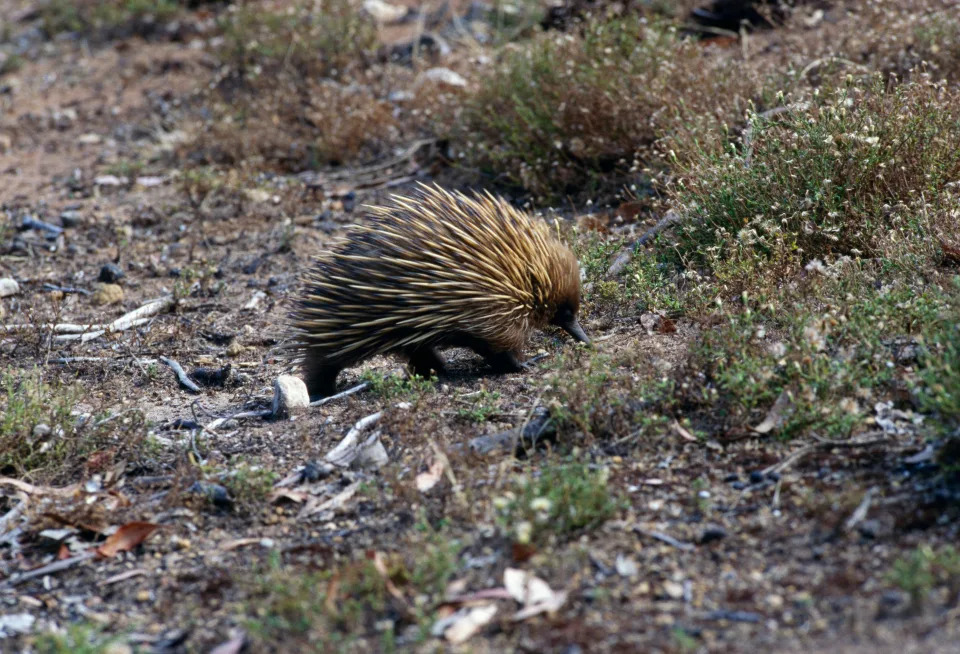
The short-beaked Echidna species is found in Australia, and is closely related to the species re-discovered in this study.DeAgostini/Getty Images
Echidnas are part of a group of animals called monotremes, which is the only group of mammals that lay eggs instead of giving birth to live young.
Echidnas are one of only five remaining monotreme species in the world. This group also includes the platypus.
The spiny critters are notoriously difficult to find since they're nocturnal and tend to be shy. They also roll up into a ball when they feel threatened and usually only come out to mate once a year, in the summer.
Since there hadn't been a sighting in decades, scientists feared that the animal had gone extinct, The New York Times reported.
The mountainous jungle echidna's call home

Gison Morib setting up one of the 80 camera traps which were placed in the Cyclops Mountains.Expedition Cyclops
Another complicating factor is that Sir David's echidna lives in a mountainous jungle region that's difficult for researchers to explore. The researchers were only able to conduct their research with help from local organizations, according to the news release.
During the course of the study, one researcher contracted malaria, another broke his arm in two places, and a third had a leech latch onto his eye for a day and a half, per the news release.
"I think the landscape is magical, at once enchanting and dangerous, like something out of a Tolkien book," Kempton said. The expedition also uncovered lots of other intriguing animals, like a never-before-seen species of shrimp that lives in trees and on the ground.
Nina Massey, PA Science Correspondent
Fri, November 10, 2023

A rare egg-laying mammal named after Sir David Attenborough – which had been lost for more than 60 years – has been captured on video for the first time.
An expedition team has rediscovered Attenborough’s long-beaked echidna, an animal that had previously only been recorded once by science in 1961.
It was captured for the first time in photos and video footage using remote trail cameras set up in the Cyclops Mountains of Indonesia’s Papua Province.
The elusive animal has the spines of a hedgehog, the snout of an anteater, and the feet of a mole.
Because of its hybrid appearance, it shares its name with a creature of Greek mythology that is half human, half serpent.
The creatures are nocturnal, and so are notoriously difficult to spot.
Additionally, Attenborough’s echidna is currently classified as Critically Endangered on the IUCN Red List of Threatened Species.
However, after four weeks, on the last day of Expedition Cyclops, with the last images on the final memory card, the team obtained their shots of the elusive mammal – the first-ever photographs of Attenborough’s echidna.
Dr James Kempton, department of Biology at University of Oxford, told BBC Radio 4’s Today programme: “When we discovered it, there was initially just this great sense of relief.
“Because this expedition was three and a half years of planning and we’d seen signs of the echidna or in the field, the holes that it makes when it forages, but no pictures until that very final day.”
He added: “Initially it’s this intense relief but instantaneously afterwards a great sense of euphoria.
“I was the the last scientist who had remained, I’d already come down from the mountains and I was looking through the images for the echidna and just burst out beaming and ran out into the living room of the base house where we were, and said to my Papuan colleagues, who are still with me, ‘we found it, we found it’.”
Attenborough’s long-beaked echidna is a monotreme – an egg-laying group that separated from the rest of the mammal tree of life about 200 million years ago.
The echidna species is so special because it is one of only five remaining species of monotremes.
To give themselves the best chance of finding the animal, the team deployed more than 80 trail cameras, making multiple ascents of the mountains, and climbing more than 11,000 meters (more than the height of Mount Everest) in the process.
For almost the entire four weeks that the team spent in the forest, the cameras recorded no sign of the echidna.
As well as searching for the echidna, the expedition carried out the first comprehensive assessment of invertebrate, reptile, amphibian and mammal life in the Cyclops Mountains.
By combining scientific techniques with the Papuan team members’ experience and knowledge of the forest, the team made a number of new discoveries, including several dozens of insect species completely new to science.
They also rediscovered Mayr’s honeyeater (Ptiloprora mayri), a bird lost to science since 2008 and named after famed evolutionary biologist Ernst Mayr.
The researchers were surprised to find an entirely new genus of ground and tree-dwelling shrimp.
Dr Leonidas-Romanos Davranoglou, a Leverhulme Trust Postdoctoral Fellow at the Oxford University Museum of Natural History, was the lead entomologist for the expedition.
He said: “We were quite shocked to discover this shrimp in the heart of the forest because it is a remarkable departure from the typical seaside habitat for these animals.
“We believe that the high level of rainfall in the Cyclops Mountains means the humidity is great enough for these creatures to live entirely on land.”
The expedition was a partnership between the University of Oxford, Indonesian NGO Yayasan Pelayanan Papua Nenda (YAPPENDA), Cenderawasih University (UNCEN), Papua BBKSDA, and the National Research and Innovation Agency of Indonesia (BRIN), Re:Wild.
Scientists took the first-ever photos of an adorable echidna, named after David Attenborough, that hasn't been seen for over 60 years
Sonam Sheth,Maiya Focht
Fri, November 10, 2023

Scientists captured images of an elusive echidna named after David Attenborough for the first time in over 60 years.
Attenborough's long-beaked echidna was last recorded in 1961.
Researchers dispatched 80 camera traps that finally spotted this adorable creature.
Scientists captured images of an elusive echidna named after the British biologist Sir David Attenborough for the first time in over 60 years.
Attenborough's long-beaked echidna was last recorded in 1961, according to a news release from the University of Oxford.
A team of researchers dispatched 80 camera traps to capture the first-ever video and photos of the animal.
The photos were taken at night, so it might be easy to mistake the animal's spines for fur in the photo. "Attenborough's long-beaked echidna has the spines of a hedgehog, the snout of an anteater, and the feet of a mole," James Kempton, a biologist from the University of Oxford who led the exploration, said in the release.
The echidna — also known as Sir David's long-beaked echidna or the Cyclops long-beaked echidna — inhabits New Guinea and lives in the Cyclops Mountains in Indonesia.
"The discovery is the result of a lot of hard work and over three and a half years of planning," Kempton said in the release.
What is the echidna?

The short-beaked Echidna species is found in Australia, and is closely related to the species re-discovered in this study.DeAgostini/Getty Images
Echidnas are part of a group of animals called monotremes, which is the only group of mammals that lay eggs instead of giving birth to live young.
Echidnas are one of only five remaining monotreme species in the world. This group also includes the platypus.
The spiny critters are notoriously difficult to find since they're nocturnal and tend to be shy. They also roll up into a ball when they feel threatened and usually only come out to mate once a year, in the summer.
Since there hadn't been a sighting in decades, scientists feared that the animal had gone extinct, The New York Times reported.
The mountainous jungle echidna's call home

Gison Morib setting up one of the 80 camera traps which were placed in the Cyclops Mountains.Expedition Cyclops
Another complicating factor is that Sir David's echidna lives in a mountainous jungle region that's difficult for researchers to explore. The researchers were only able to conduct their research with help from local organizations, according to the news release.
During the course of the study, one researcher contracted malaria, another broke his arm in two places, and a third had a leech latch onto his eye for a day and a half, per the news release.
"I think the landscape is magical, at once enchanting and dangerous, like something out of a Tolkien book," Kempton said. The expedition also uncovered lots of other intriguing animals, like a never-before-seen species of shrimp that lives in trees and on the ground.
A catalyst for conservation
The long-beaked echidna is listed as Critically Endangered on the IUCN Red List of Threatened Species, according to the news release.
Part of the reason may be because the tropical forests surrounding the Cyclops Mountains are under threat from logging and mining, per the Times.
"I really hope and believe this will become a catalyst for strong conservation of the Cyclops Mountain Range," Iain Kobak, a co-founder of Yappenda that organized and trained people for the expedition, told the Times.
Attenborough’s long-lost echidna rediscovered in New Guinea jungle
Nick Squires
Fri, November 10, 2023
A long-lost species of egg-laying mammal named after Sir David Attenborough has been rediscovered by a British-led expedition in the dense jungles of New Guinea more than 60 years after it was last spotted.
A living specimen of Sir David’s long-beaked echidna, which resembles a large hedgehog with a long snout, was last documented in 1961.
Scientists had no idea whether it had become extinct or not. But it has now been filmed by a University of Oxford expedition in the Cyclops Mountains of Papua, the Indonesian half of the island of New Guinea.
It is the first video footage ever recorded of the species.
A multinational team of scientists braved earthquakes, sheer cliffs, deadly snakes, malaria and blood-sucking leeches as they scoured the rainforest for the elusive creature.
The long-beaked echidna was captured on a trail camera on the very last day of a month-long expedition. Images of the creature were found on the last memory card retrieved from more than 80 cameras that had been set up in the rainforest by the scientists.
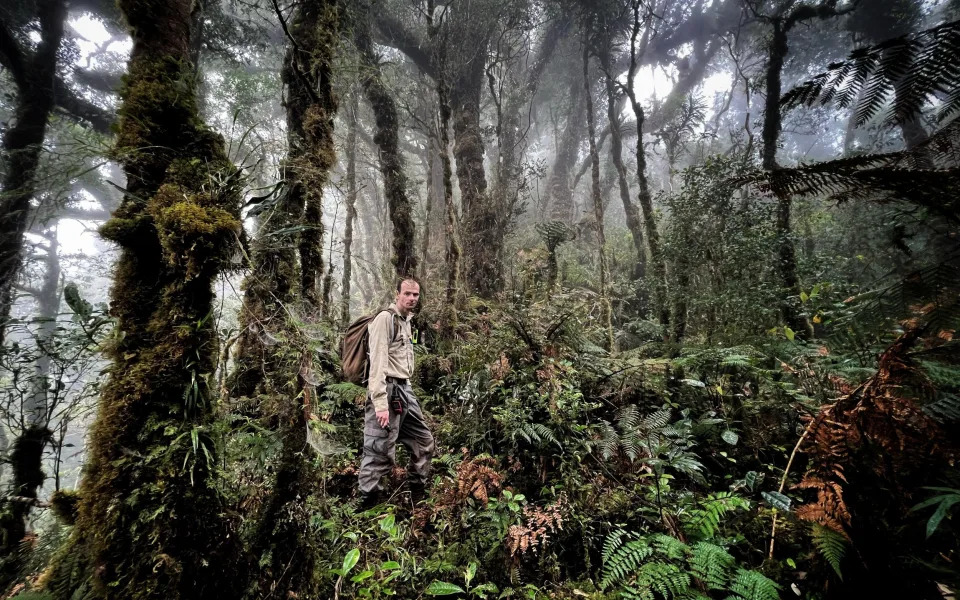
Dr James Kempton and his team spotted the species in the jungles of the Cyclops mountains of Indonesia's Papua Province - Expedition Cyclops
“I’m not joking when I say it came down to the very last SD card that we looked at, from the very last camera that we collected, on the very last day of our expedition,” biologist Dr James Kempton told the BBC.
The camera trap footage shows the animal waddling across the forest floor with a distinctive loping gait.
“(The reason) it appears so unlike other mammals is because it is a member of the monotremes – an egg-laying group that separated from the rest of the mammal tree-of-life about 200 million years ago,” Dr Kempton said in a statement.
He said the animal has “the spines of a hedgehog, the snout of an anteater and the feet of a mole”.
The last time the species was recorded scientifically was by a Dutch botanist in 1961. The only evidence that the species existed, until now, was a specimen held by a museum in the Netherlands.

Attenborough’s long-beaked echidna echidna walks amid vegetation in the Cyclops Mountains, Papua, Indonesia
The importance of the specimen was revealed in 1998, when x-rays showed it wasn’t a juvenile of another echidna species, but in fact fully grown and distinct. The species was named after Sir David following the discovery.
One of the many unusual features of echidnas is the fact that they are equipped with a four-pronged penis. It has four separate heads, or glans, although only two of them are used during each erection.
Sir David’s long-beaked echidna, also known as Attenborough’s long-beaked echidna, plays an important part in local culture, with a tradition saying that if a conflict breaks out between villagers, one party should be sent into the jungle to look for one of the animals while another should travel to the coast of New Guinea to find a marlin.
Both creatures are so rare that finding them could take years or decades, by which time the reasons for the conflict would be forgotten.
The scientifically named Zaglossus attenboroughi is classified as critically endangered because of habitat loss and hunting for its meat. The only living relative of the echidnas is the duck-billed platypus of Australia.
Aside from rediscovering the lost echidna, the expedition also found two new species of frog and a new species of terrestrial shrimp as they explored the Cyclops Mountains. The scientists are calling for the region to be given much better protection.
“With 83 per cent of Indonesian New Guinea’s old-growth forest still intact, we are at a critical moment to ensure the preservation of the world’s most biodiverse island,” said Dr Kempton.
Endangered egg-laying mammal seen for the first time in over 60 years
Natalie Kainz
Fri, November 10, 2023
An expedition through an unpredictable, perilous mountain range in Indonesia’s province of Papua led to the rediscovery of a critically endangered egg-laying mammal that hasn’t been seen for more than 60 years.
For the researchers of Expedition Cyclops, Attenborough’s long-beaked echidna — a bizarre-looking, quill-covered creature with powerful digging feet — is a symbol of the biodiversity that can be rediscovered in Indonesia’s Cyclops Mountains.
On a nine-week expedition, a 25-person crew battled malaria and earthquakes, and one student researcher even had a leech stuck in their eye for 33 hours.
“Climbing those mountains I like to think of as climbing a ladder whose rungs are made of rotting wood, with rails cladded in spikes and thorns, and a frame shrouded by sunken vines and falling rocks,” said team leader James Kempton of Oxford.
The less than 90-square-mile mountain range has been subject to illegal hunting for years. It’s the only habitat for Attenborough’s long-beaked echidna, which is considered critically endangered and is on the International Union for the Conservation of Nature’s Red List of Threatened Species.
Kempton’s team deployed over 30 camera traps to look for the echidna, suspecting it was around because of holes in the ground the animal uses to forage for worms. In the last images on the last SD card on the final day of the expedition, they finally found it.
“The first feeling was one of great relief, because we had tried so hard and thought they were there, but we needed concrete evidence for the scientific proof,” said Kempton. “That was followed by extreme euphoria.”
Kempton said the echidna’s critically endangered status is unlikely to change for a long time and is not protected under Indonesian law.
The effort to change that is among the reasons why Expedition Cyclops included more than six local partners in its research project, said Kempton. These include Indigenous groups, students and organizations of the Indonesian government.
Kempton hopes the findings will help local partners raise funds to research and protect the Cyclops Mountains.
The Attenborough’s long-beaked echidna is also one of five guardians of a highly unique and fragile evolutionary history that dates back over 200 million years, said Kempton.
Echidnas are monotremes, which means they are part of the only group of living mammals that lays eggs instead of bearing live young, he explained. There are only five existing species of monotremes: the platypus and four species of echidna.
“To a biologist, the idea that that branch could go extinct would be a great tragedy,” Kempton said. “It’s evolutionary history that can never be gained back.”
Rediscovering Attenborough’s long-beaked echidna was only one of the goals of Expedition Cyclops. Researchers also set out to investigate the origins of the biodiversity of the Cyclops Mountains. They came back with hundreds of new insect species, at least two new species of frogs, and a new species of shrimp that lives on land and in trees.
Kempton said the Cyclops Mountains’ unique geologic origins are a huge driving force behind the region’s biodiversity. The mountain range used to be islands in the middle of the Pacific Ocean. As the Earth’s continents gradually drifted together, they collided with the mainland of New Guinea to form mountains.
Expedition Cyclops also rediscovered Mayr’s honeyeater, a species of bird not seen for 15 years.
This article was originally published on NBCNews.com

